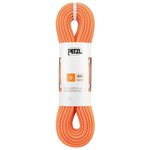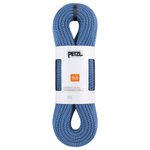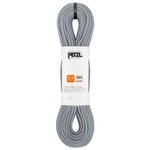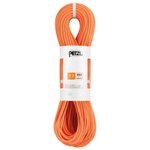Climbing ropes
Discover our range of climbing and mountaineering ropes, essential for your safety. Whether you need dynamic ropes, single or double ropes, our selection covers all your needs. Choosing the right length, diameter, and rope type can be overwhelming, but we're here to guide you. Explore our catalogue and find the rope that suits you at an affordable price from top brands like Beal, Edelrid, Mammut, and Petzl, available in lengths of 30m, 40m, 50m, 60m, 70m, and 80m.
Read more Show less
 Deals
Deals
-
Recommended price
£108.66
-20%
From £86.91
- 30
- 40
- 50
- 60

 Deals
Deals
-
Recommended price
£165.21
-24%
From £125.19
-
- 60
- 70
- 80

 Deals
Deals
-
Recommended price
£143.46
-24%
From £108.66
- 50
- 60
- 70

 Deals
Deals
-
Recommended price
£143.46
-24%
From £108.66
- 50
- 60
- 70
Loading...
How to Choose a Climbing Rope: Key Elements
Choosing a climbing rope depends on several key factors:
- Rope Type: Depending on your discipline, you’ll choose between single, half, or twin ropes. For indoor or sport climbing, a single rope is recommended. For multi-pitch routes or mountaineering, a half rope is preferable.
- Diameter and Weight: The diameter affects the rope’s strength and weight. A thicker rope is more durable but also heavier.
- Length: The rope length should match the height of the routes you plan to climb.
- Lifespan and Care: A well-maintained rope can last for several years. Its longevity depends on usage frequency and storage conditions.
- Markings and Special Treatments: Some ropes feature a middle mark for easier handling, or special treatments for enhanced durability.
Consider these factors to find the best rope for your needs.
Difference Between Single, Half, and Twin Ropes
The single rope is the most common and is ideal for sport climbing in gyms or outdoor crags. It consists of a single strand, making it easy to handle. Single ropes vary in diameter, ranging from ultra-thin (8.9 mm) to thicker (up to 10.5 mm).
Half ropes consist of two thinner strands that are clipped alternately to reduce rope drag and lower impact forces in case of a fall. They are ideal for mountaineering and multi-pitch climbing, as they allow efficient rappelling and minimize stress on anchor points.
Twin ropes are similar to half ropes but are used differently. The climber clips both strands together in every bolt, much like a single rope, but with the added security of redundancy. While twin ropes don’t reduce rope drag, they offer flexibility for alpine climbing and long rappels.
- Single Rope: One strand, ideal for sport climbing and single-pitch routes.
- Half Rope: Two strands, great for mountaineering and multi-pitch climbing.
- Twin Rope: Two strands used together, useful for long climbs but often replaced by half ropes.
Your choice depends on the type of climbing you plan to do.
How to Choose the Diameter and Length of Your Rope: 60m, 70m, or 80m?
The diameter of your rope should match your skill level and climbing style. For beginners and indoor climbers, a diameter between 9.5 mm and 10.2 mm offers excellent grip and durability. This thickness also prevents the rope from running too fast through a belay device, improving safety.
Advanced climbers may prefer thinner ropes, ranging from 8.9 to 9.4 mm, for reduced weight and better handling.
Note: Ropes thinner than 9.4 mm can slide quickly through belay devices like the Reverso. Inexperienced belayers might struggle to control a fall properly.
When it comes to length, it depends on the type of climbing you do. Indoor climbing typically requires a shorter rope (around 35 meters), while outdoor climbing calls for longer ropes between 50m and 80m. A 70-meter rope is a versatile choice for most sport climbing routes.
For very long routes, an 80-meter rope offers extra flexibility, though its added weight can be a drawback.
Tip: Always secure the rope’s end with a knot or attach it to your rope bag to prevent accidental lowering off the rope’s end.
Climbing Rope Care: Washing and Storage
Proper maintenance can extend your rope’s lifespan. To clean it, use water below 30°C and a mild detergent, such as Marseille soap. Soak the rope in a tub for about an hour, or wash it in a machine with great care.
Drying should be done away from UV exposure and heat sources. Lay the rope in loose coils or chain loops.
Washing removes dirt and sand particles that can wear down the rope’s core and sheath over time.
Inspect your rope regularly for signs of wear. If pinching a loop of rope between your thumb and index finger results in both strands touching, it’s a sign the rope has lost its elasticity and should be replaced. If it holds its shape with space in the middle, it is still in good condition.
Best Ropes for Mountaineering: Hydrophobic Treatments
For mountaineering, rope selection is crucial for comfort and safety. Half ropes are often preferred due to their lightweight and versatility. They are clipped alternately to reduce drag and lower impact forces. This is particularly important in mountaineering, where placements (pitons, slings, cams, ice screws) need to absorb less force to avoid pulling out anchors.
For harsh alpine conditions, choose hydrophobic-treated ropes such as Golden Dry, Dry Cover, or Pro Dry. These treatments prevent the rope from absorbing water, which can cause freezing, stiffness, and added weight.
Additionally, a rope with a reinforced sheath provides better resistance against sharp edges and abrasion.
Understanding Impact Force and Dynamic Ropes
The impact force is a crucial concept in climbing. It represents the maximum force exerted on the climber and gear during a fall, measured in Kilonewtons (kN). It depends on:
- The climber’s weight.
- The fall factor.
- The rope’s elasticity.
A high-quality climbing rope should have a low impact force to better absorb falls. Ideally, a good rope has an impact force around 7kN (700 kg).
This is why climbing ropes are dynamic—they stretch under load to absorb fall energy.
Essential Accessory: Rope Bags
A rope bag is a must-have for protecting and transporting your climbing gear. Some rope bags are large enough to store your harness, climbing shoes, quickdraws, and other essentials. Some models are designed as backpacks for multi-pitch routes, while others include an integrated tarp to keep your rope clean.
This accessory is just as essential as the rope itself for a perfect climbing experience.




